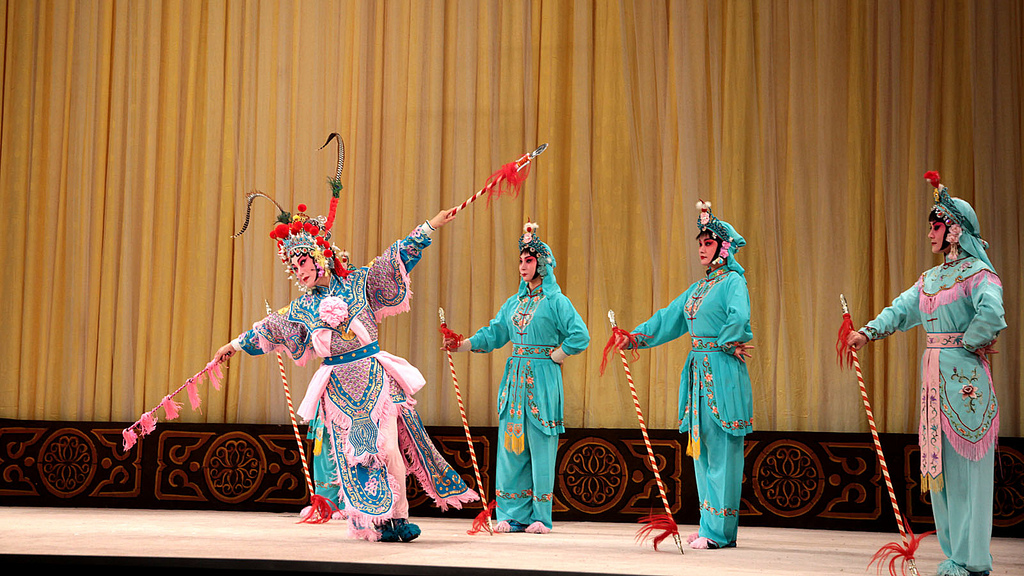Stage art indispensable to traditional operas

Hu Sanniang, a fictional character in The Water Margin, waves a spear around as she makes her entrance on stage.
Chinese playwright Cao Yu (1910-1996), born Wan Jiabao, once defined the relationship between drama and stage art concisely: “Plays can’t survive without stage art.”
Defined as various elements of a play, including lights, music, props, costumes and other items built for productions, stage art emerged simultaneously alongside drama, and the two are inseparable from each other.
Throughout the long history of drama, stage art has been crucial to its development. They are interdependent and are mutually beneficial. They are both part of intangible culture and contribute to the prosperity of art in China.
In traditional Chinese operas, stage art does not totally rely on external material objects. It also includes performance skills and other non-material artistic means.
For example, in traditional operas, the artists can create abstract spaces, stage settings and presentations on the stage with their performances,such as singing, dialogue, acting and martial arts to form the circumstances on the stage and portray the characters.
These performances can be called established formats in stage performances. Through these means, the stage is a kind of empty space, where artists try to depict or stress the existence of non-material images solely with their own costumes, gestures, expressions and other conventional performances.
Another element of these established formats is the conventional methods artists use when entering, leaving and walking around the stage. All of them are done according to specified movements and routes.
Moreover, the appearance of a character on the stage, including the mask, hairstyle, costumes and accessories, must be in compliance with the status, personality and temperament of the character.
These are laws of the stage performances based on observations of stage designers and artists from other professions. This is a special language embodying values and ideals, fostering the unique charm of traditional operas.
One reason for this kind of performance lies with the limitations posed by historical and material conditions in the past. These prompted conscious exploration, pursuit and creative ideas of artists in order to diversify acting methods.
This kind of performance is unique in traditional Chinese operas. As world renowned master of Peking Opera Mei Lanfang points out, the setting of operas is created by the actors.
These creative elements have been recognized by the audience as symbolizing certain connotations. It is one manifestation of viewer-performer relations established during the development of operas. They also have been accepted as principles in the arts. This kind of performance not only has its own characteristics but also is rich in Chinese styles and forms.
In traditional operas, the stage is an open space allowing performers to fully demonstrate their skills in acting and the audience to fully exert their imagination for both the characters and the plot. This kind of practice of leaving space is also seen in other Chinese artistic genres, like painting and calligraphy.
Nowadays, stage artists have begun to return their focus to traditional art and attach importance to these laws of art. They have shifted the focus to innovation, instead of simply pursing grand stage settings. They are making changes and innovations by drawing upon experience from conventional performances. They also use modern technology to facilitate the stage setting, which helps portray the characters.
People are also attaching more importance to intangible culture protection. Those established laws of performances are part of intangible culture. Recognizing and examining this cultural language can enhance our confidence in our own culture and also encourage stage artists.
Therefore, the study of stage art is closely related to the protection and inheritance of operas. In terms of stage art, many stage designers and technicians are endeavoring to overcome the limitations of those conventional performances, while absorbing the essence of traditional art forms, to expand their own capacities.
In this process, two things need attention. One is that it is necessary to train talent who can engage in all types of work involved in operas and enhance the basic quality of practitioners in this area. It is imperative to cultivate inheritors of traditional stage art to save and protect the art form, and a echelon of inheritors should be formed. The second is that there is a need for experts adroit at crafts and techniques as well as masters of opera who can grasp the overall situation and be leaders at the task.
